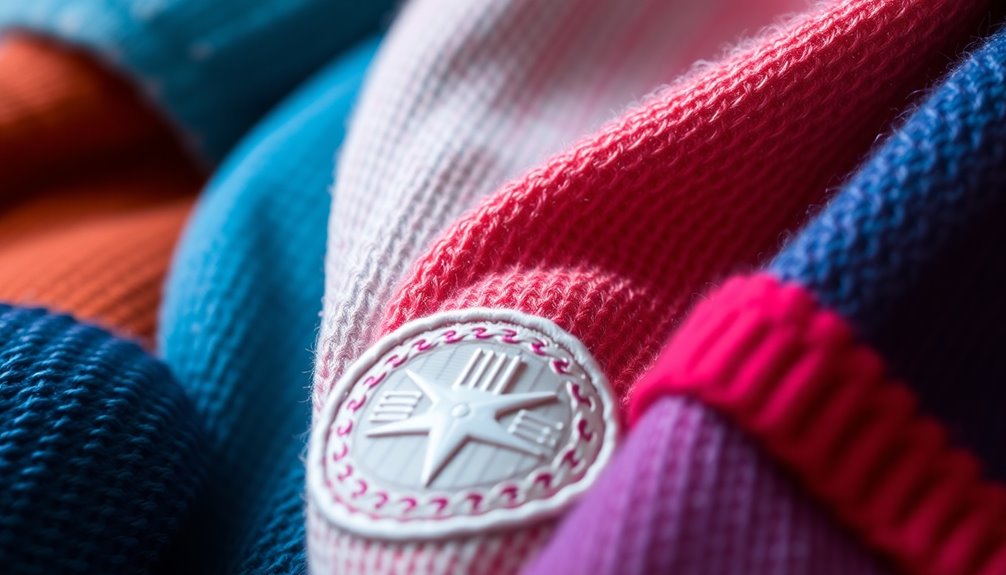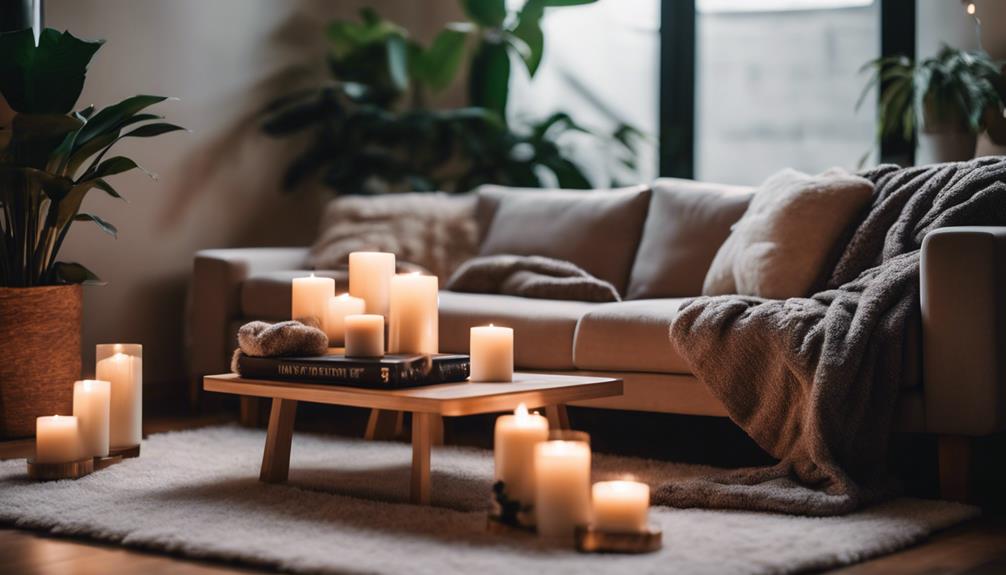Clothing logos are more than just symbols; they reflect your authentic style and individuality. Originating in the late 19th century, these logos showcase a brand's identity and heritage. From iconic designs like Chanel's interlocking Cs to the bold statements of streetwear brands, each logo tells a story. Today, logos serve as cultural markers, tying you to movements and trends. When styled correctly, they enhance your outfit without overshadowing it. Understanding how to choose and wear logos can transform your fashion game. Stick around for tips on making logos work for you and their impact on your personal style!
Key Takeaways
- Clothing logos serve as visual identities, establishing brand authenticity and quality since the late 19th century, exemplified by pioneers like Louis Vuitton and Levi's.
- Iconic logos like Chanel's interlocking Cs and Gucci's double Gs create strong brand narratives, enhancing their recognition and cultural relevance.
- Contemporary fashion influencers and collaborations, such as Rihanna with Puma, elevate logos into symbols of lifestyle and authenticity for consumers.
- Effective typography and design, including custom fonts and strategic use of negative space, enhance logo memorability and brand impact.
- Sustainable fashion trends drive modern branding practices, with eco-friendly logos reflecting consumer demand for authenticity and responsible fashion choices.
Origin and historical background of the fashion trend/style
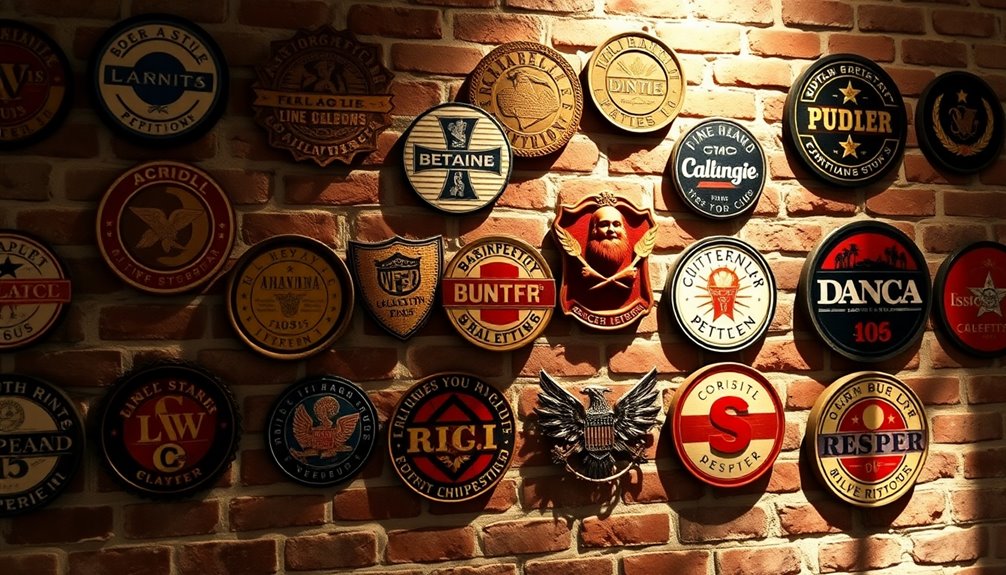
You might be surprised to learn that the use of logos in fashion dates back to the late 19th century, with brands like Louis Vuitton setting the stage for visual identity.
As you explore the transformative journey of fashion, consider how icons and innovators shaped this trend, influencing everything from luxury craftsmanship to streetwear culture.
Understanding this history can give you a deeper appreciation for the logos that dominate today's fashion landscape.
Fashion's Transformative Journey
Fashion's transformative journey can be traced back to the late 19th century when brands like Levi Strauss & Co. began to roll out logo branding as a means to signify quality and authenticity. The iconic batwing logo set the stage for the rise of the fashion brand logo, which became a symbol of trust for consumers.
As you move into the early 20th century, luxury fashion brands like Chanel and Louis Vuitton introduced monograms and symbols that emphasized heritage and craftsmanship, further entrenching logos in brand design.
Post-World War II, American sportswear brands shifted the focus to lifestyle branding, with Ralph Lauren and Calvin Klein anchoring their identities through distinct logos that spoke to their target audience.
The 1980s brought a bold new direction, where designers like Gianni Versace used striking imagery and typography to reflect opulence and a rebellious spirit.
In recent years, minimalist and sustainable logo designs have emerged, catering to contemporary consumer preferences. Brands like Everlane and Reformation illustrate this shift towards authenticity and ethical branding, proving that fashion logos continue to evolve as essential markers of style and identity.
Fashion Icons and Innovators
Throughout history, iconic figures in fashion have shaped styles and trends, leaving a lasting impact on the industry. The use of logos began in the late 19th century when luxury brands like Louis Vuitton introduced distinctive marks to signify their craftsmanship and status.
As fashion designers like Coco Chanel and Guccio Gucci emerged, they leveraged their logo features to build strong brand identities. Chanel's interlocking Cs and Gucci's double Gs became powerful symbols of high fashion, instantly recognizable and coveted.
By the 1980s, streetwear culture blossomed, with brands like Stüssy and Supreme utilizing bold logos to connect with urban youth. This period highlighted a shift toward casual yet stylish aesthetics, emphasizing the importance of a brand name in everyday fashion.
As we moved into the 2000s, luxury brand logos transitioned to minimalism, focusing on elegance and sophistication, as seen in Calvin Klein and Prada.
Today, logos aren't just identifiers; they serve as cultural symbols reflecting modern consumers' values, especially around sustainability and ethical fashion. Gold IRAs provide a unique example of how branding can influence financial choices, as consumers increasingly seek investments that align with their values. Fashion icons and innovators continue to influence how logos define not only style but also our aspirations in the fashion world.
Key Characteristics
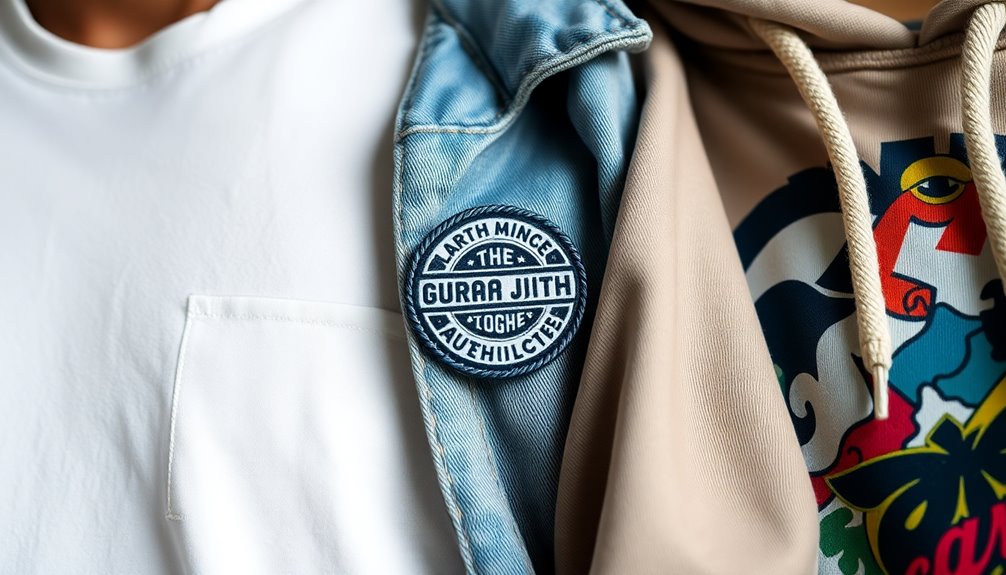
When you think about clothing logos, distinctive typography styles stand out as a key characteristic that sets brands apart.
You'll notice how natural fabrics and hues complement these logos, creating a cohesive look that resonates with the audience.
Additionally, timeless fashion staples often feature logos that enhance their appeal and longevity in the market.
Distinctive Typography Styles
Distinctive typography styles play a crucial role in creating memorable clothing logos that resonate with consumers. When you think about successful fashion logo designs, custom fonts and unique lettering often come to mind. These elements enhance brand identity, making logos instantly recognizable.
Luxury brands frequently opt for cursive and script fonts, like those seen in Cartier and Oscar De La Renta. This choice conveys elegance and a personal touch, appealing to a discerning clientele.
On the other hand, serif fonts, utilized by brands like Hugo Boss and Chanel, signify sophistication and timelessness, drawing in an upscale audience.
If you prefer a modern aesthetic, bold and geometric typography is the way to go. Brands like Supreme and Nike exemplify this style, connecting with contemporary consumers and urban culture.
Effective logo typography blends clarity and creativity, ensuring that the brand message is communicated while remaining visually appealing and memorable.
Ultimately, the right typography can transform a simple logo into a powerful branding tool that captures attention and loyalty.
Natural Fabrics and Hues
The choice of natural fabrics and hues can significantly impact the overall appeal of clothing logos and brand identity. When you opt for materials like cotton, linen, wool, and silk, you're not just prioritizing comfort and breathability; you're also enhancing the aesthetic of your brand.
These natural fabrics often come in earthy hues derived from natural dyes, offering a softer, more organic look compared to synthetic options. By incorporating these elements, you align your brand with sustainability, as natural fibers are biodegradable and typically produced with a lower environmental footprint.
They require less energy and water during production, making them a more responsible choice for eco-conscious consumers. Moreover, the texture and durability of natural fabrics contribute to the quality of your clothing.
Garments made from these materials age beautifully and last longer, which means fewer replacements and a more sustainable wardrobe. By focusing on natural fabrics and earthy hues, you create a brand identity that resonates with consumers seeking authenticity and style, while promoting a commitment to sustainability and quality clothing.
Timeless Fashion Staples
Timeless fashion staples possess an enduring appeal, often characterized by simple yet recognizable logos that enhance brand memorability. When you look at iconic fashion houses like Ralph Lauren and Levi's, you'll notice their logos typically use a limited color palette, maintaining elegance and versatility. This simplicity allows their branding to shine across various mediums.
High-quality typography is another hallmark of these staples. Logos often feature custom or serif fonts that convey sophistication, aligning perfectly with the brand's heritage. Think about the classic feel of a well-crafted serif font—it speaks volumes about the brand's identity and style.
Additionally, effective use of negative space in logo design adds depth and creativity while keeping the overall aesthetic clean. Brands like Chanel and Gucci exemplify this approach, ensuring their logos are instantly recognizable and impactful.
Consistency in logo application is crucial too. When a brand maintains its logo across products and marketing materials, it reinforces identity and fosters consumer loyalty.
This coherence is what turns a mere logo into a mark of authentic style, making it an essential characteristic of timeless fashion staples.
Modern Interpretation

When you look at modern clothing logos, you'll notice how sustainable fashion innovations are shaping brand identities today.
Renowned fashion houses are increasingly adopting eco-friendly practices, while fashion influencers and icons are using their platforms to promote these conscious designs.
This shift not only reflects a commitment to the environment but also resonates with consumers seeking authenticity and purpose in their fashion choices. Furthermore, many brands are beginning to incorporate renewable energy technologies to power their production processes, further enhancing their sustainability efforts.
Sustainable Fashion Innovations
Sustainable fashion innovations are transforming the way you think about clothing, blending style with environmental responsibility. Brands like Stella McCartney are leading the charge by utilizing eco-friendly materials, such as organic cotton and recycled polyester, to minimize their environmental impact.
As consumer demand for ethically produced clothing grows, the global market for sustainable fashion is projected to reach $8.25 billion by 2023.
You'll also see brands like Patagonia and Eileen Fisher implementing circular fashion models, encouraging the recycling and upcycling of garments. This approach not only reduces waste but extends the life cycle of your favorite pieces.
Plus, advancements in technology are playing a crucial role; AI-driven design processes and blockchain solutions enhance traceability and help reduce carbon footprints. Furthermore, with the emergence of renewable energy technologies, brands are increasingly able to power their production processes more sustainably.
Certifications like the Global Organic Textile Standard (GOTS) and Fair Trade are becoming more prominent, guiding you toward brands that adhere to rigorous sustainability and ethical production standards.
Renowned Fashion Houses
Fashion logos are more than just symbols; they encapsulate a brand's identity and heritage. Renowned fashion houses like Gucci and Chanel have embraced modern design, transforming their logos into minimalist masterpieces that enhance brand recognition while exuding luxury.
The interlocking Gs of Gucci, for instance, are sleek and clean, resonating with contemporary aesthetics while honoring the brand's rich history. Chanel's iconic double C logo epitomizes sophistication and elegance, frequently adapting its use in various marketing campaigns to stay relevant in today's fast-paced fashion landscape.
Similarly, brands like Prada and Versace utilize bold typography and distinct symbols to convey their unique identities. Versace's Medusa emblem, for example, symbolizes power and allure, making a striking impact in modern fashion.
Luxury fashion houses, including Louis Vuitton, creatively leverage their monogram patterns, merging traditional elements with modern design techniques to appeal to today's consumers.
This blend of heritage and innovation not only strengthens their brand recognition but also ensures they remain at the forefront of the luxury goods market. Embracing modern interpretations allows these iconic brands to maintain their relevance while celebrating their storied legacies.
Fashion Influencers and Icons
In today's dynamic landscape, countless fashion influencers and icons are redefining personal branding through the power of unique clothing logos. You'll notice how figures like Chiara Ferragni leverage her recognizable eye logo to connect with followers, creating exclusive collections that truly resonate.
Icons such as Rihanna and Kanye West don't just wear fashion; they embody it by launching successful lines like Fenty, which exude empowerment and creativity through bold designs.
The rise of social media amplifies the significance of clothing brand logos. Influencers showcase their outfits on platforms like Instagram, making these logos essential elements of their personal branding.
Virgil Abloh's Off-White brand, with its distinctive quotation-mark logos, challenges traditional fashion conventions while celebrating urban culture.
Collaborations, such as Travis Scott's partnership with Nike, demonstrate how logos evolve into cultural symbols, signifying authenticity and exclusivity within the fashion community.
As you navigate this vibrant world, remember that these logos aren't just designs; they encapsulate stories, identities, and movements that shape contemporary fashion. The influence of AI-driven predictive analytics is also reshaping marketing strategies, allowing brands to tailor their offerings to consumer preferences more effectively.
Embrace the influence of these fashion icons as they continue to inspire your style journey.
Styling Tips
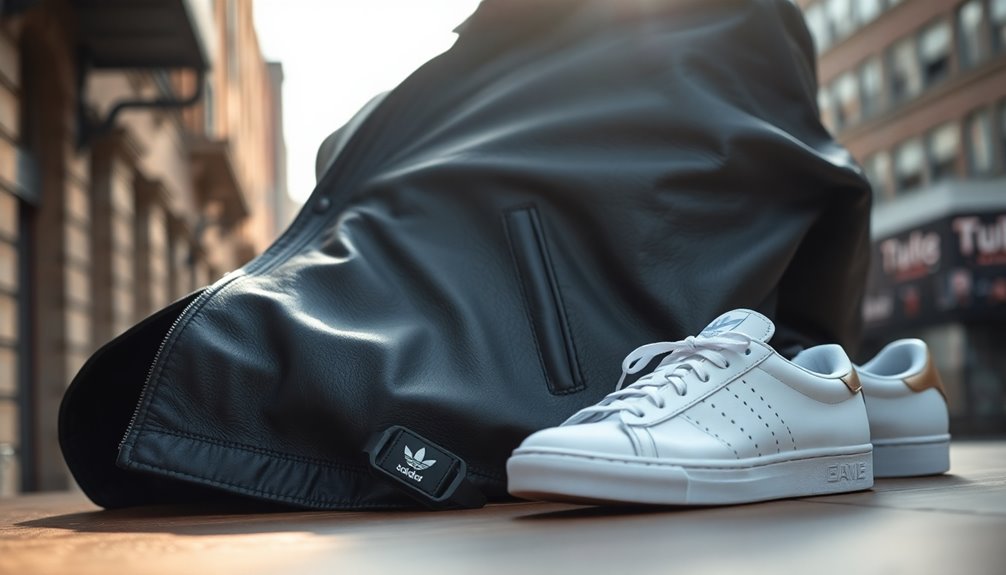
When it comes to styling with clothing logos, think about essential layering pieces to add depth to your look.
Seasonal wardrobe essentials can also help you incorporate logos in a way that feels fresh and relevant.
Plus, mastering color coordination techniques ensures your logos enhance your outfit rather than overwhelm it.
Essential Layering Pieces
Layering is an art that transforms outfits into dynamic expressions of personal style. To master this technique, start with essential layering pieces like classic turtlenecks, lightweight cardigans, and denim jackets. These items add depth and versatility, allowing you to create looks for any occasion.
Begin with a fitted base layer, such as a long-sleeve shirt, which provides warmth without bulk, making it perfect for transitional weather. Opt for neutral colors in your base layers and layering pieces; this ensures they mix and match easily with other items in your wardrobe, creating a cohesive look.
To elevate your outfits further, consider incorporating a well-fitted blazer. It not only enhances casual ensembles but also serves as a polished option for professional and social settings.
Don't forget about accessories! Scarves and vests can infuse texture and visual interest into your layers, allowing for creative styling variations.
Seasonal Wardrobe Essentials
As the seasons change, it's crucial to refresh your wardrobe with essentials that keep you stylish and comfortable. Invest in versatile pieces like a tailored blazer or a classic trench coat from your favorite fashion brands. These items can easily transition between casual and formal occasions, making them indispensable for transitional seasons.
Layer lightweight sweaters or cardigans over basic tees during cooler months. This not only adds warmth but also maintains a polished look.
Don't forget to choose seasonal colors and patterns—think earthy tones in fall or soft pastels in spring—to keep your outfits fresh and aligned with current trends.
Quality footwear is a must. Opt for ankle boots in autumn or breathable sneakers during spring; they elevate your look while ensuring comfort and practicality. Consider incorporating Nike Tech into your footwear choices for enhanced performance and style.
Finally, accessorize with seasonal items like scarves and statement jewelry. These touches personalize your wardrobe essentials and add flair to your overall style.
Color Coordination Techniques
Mastering color coordination can transform your outfits from ordinary to extraordinary. Start by utilizing the color wheel to identify complementary colors—those opposite each other, like blue and orange. This creates vibrant contrasts that enhance your overall look.
Incorporate neutral colors like black, white, and gray into your wardrobe, as they mix well with any hue, providing versatility and balance. They're especially useful for toning down bold patterns.
When layering outfits, stick to a maximum of three colors. This helps maintain visual cohesion; choose one dominant color, supported by two accent shades. Employ the 60-30-10 rule: let 60% of your outfit be the primary color, 30% a secondary hue, and 10% an accent. This technique fosters a harmonious and stylish appearance.
Seasonality also influences your color schemes. Opt for earthy tones and muted colors in fall, while bright and pastel shades work wonderfully during spring and summer.
Shopping Guide
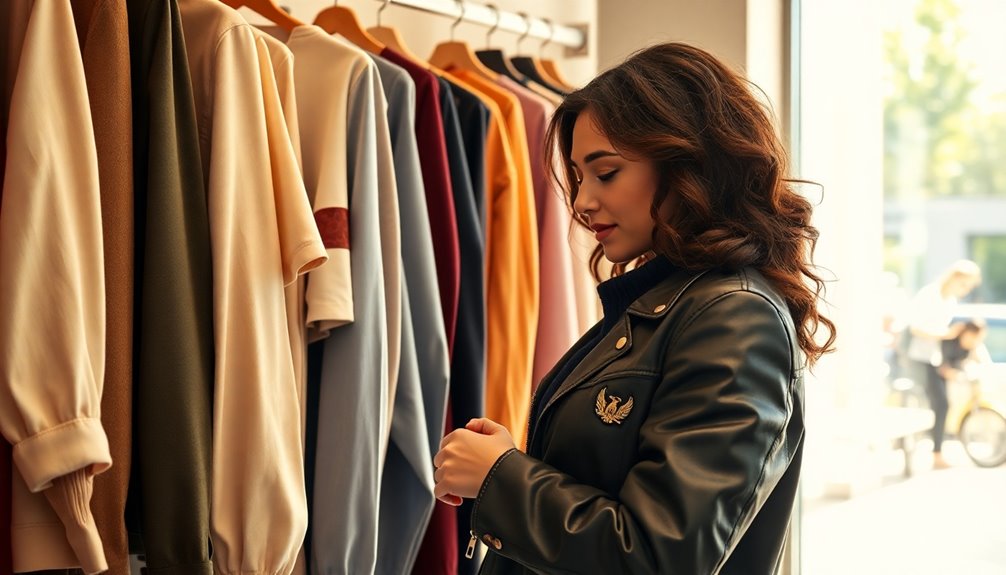
When you’re on the hunt for clothing logos, it’s essential to pay attention to elements that resonate with your personal style and values. Look for designs that not only reflect current trends but also stand the test of time, embodying versatility and uniqueness. Consider how these logos represent the quality and craftsmanship of the garments, especially if you’re seeking suit brands that elevate your style. By choosing logos that align with your aesthetic, you can express your individuality while also making a statement about the brands you support.
Start by exploring brands that use cursive typography, like Christian Louboutin and Oscar De La Renta, which can elevate your fashion sense with an elegant touch. Look for iconic monograms, such as Louis Vuitton's interlocking LV or Gucci's symmetrical Gs, as they not only symbolize luxury but also strengthen brand recognition.
Next, consider the color choices in logos. Brands like Levi's and Tommy Hilfiger use bold colors that reflect personality and attract attention.
Simplicity and uniqueness matter too; timeless designs from Chanel and Ralph Lauren enhance memorability and foster customer loyalty.
Don't overlook the emotional connection logos can create. Strong visual identities from brands like Nike and Ray-Ban often leave lasting impressions, building brand attachment.
As you shop, think about how each logo aligns with your values and style. This thoughtful approach to choosing logos won't only enhance your wardrobe but also ensure you wear brands that genuinely represent you.
Happy shopping!
Upcycling Old Garments
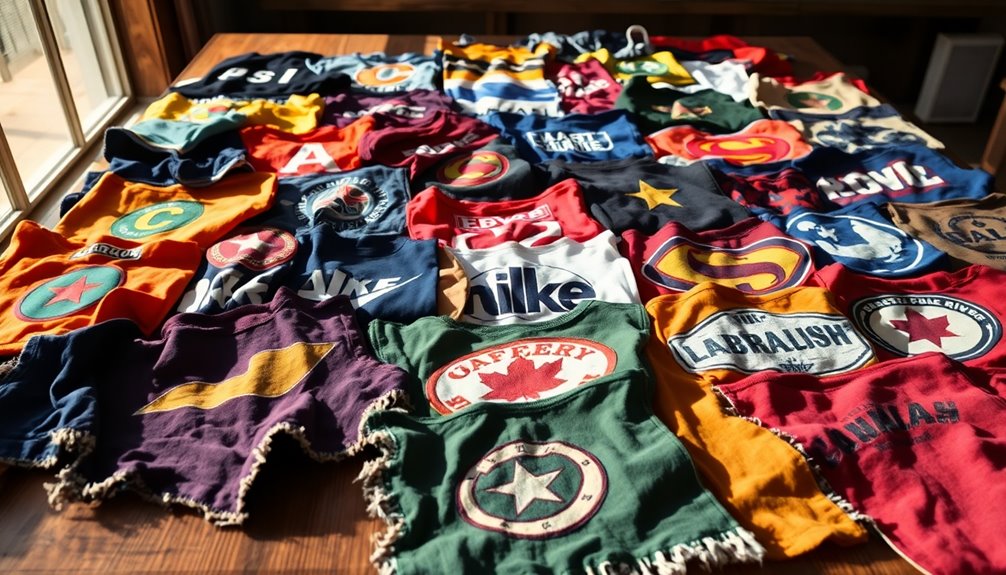
Upcycling old garments is a fantastic way to repurpose vintage clothing and give it a new life.
You can explore personalized embroidery techniques to add your unique touch, making each piece truly one-of-a-kind.
Not only does this process reduce waste, but it also showcases your individual style in a sustainable way.
Repurposing Vintage Clothing
Repurposing vintage clothing not only breathes new life into old garments but also plays a vital role in promoting a sustainable fashion industry. By upcycling old garments, you help reduce textile waste while contributing to a thriving second-hand clothing market projected to reach $64 billion by 2024.
Each piece you create tells a story and reflects your unique style, as these vintage items carry their own history and character. The process of upcycling can be as simple as cutting, dyeing, or adding embellishments, allowing for creative expression that showcases your individuality.
You don't need to break the bank; many DIY enthusiasts find materials at thrift stores or garage sales, making it a cost-effective alternative to buying new. Plus, extending the life of clothing by just nine months can significantly reduce its carbon, water, and waste footprints by 20-30%.
Personalized Embroidery Techniques
Personalized embroidery techniques can truly transform old garments into standout fashion pieces that reflect your unique style. By embracing upcycling, you can breathe new life into items that might otherwise end up in the landfill.
Common methods like hand embroidery, machine embroidery, and the addition of patches or sequins allow you to express your creativity and customize your wardrobe.
Utilizing sustainable materials, such as organic threads and recycled fabrics, not only enhances the aesthetic of your pieces but also supports eco-friendly fashion practices. You can even use embroidery to cover stains or damages, effectively revitalizing garments that have lost their charm.
Learning basic embroidery stitches—like backstitch, satin stitch, and French knots—empowers you to personalize your clothing further.
With just a little practice, you can create unique patterns or embellishments that resonate with your individual style.
Cultural Impact
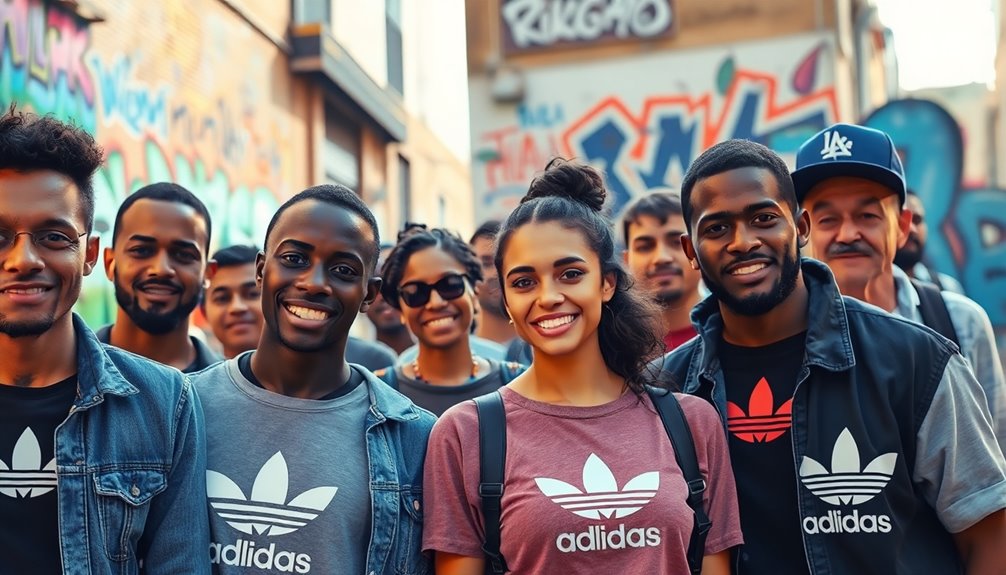
When you think about clothing logos, consider how they shape cultural narratives in film and music.
Iconic logos often symbolize movements or messages, linking fashion with activism and sparking conversations about social issues.
These connections not only influence your style choices but also reflect broader societal values and trends.
Fashion in Film and Music
Fashion in film and music has a profound cultural impact, shaping not only trends but also the logos we associate with various brands. Iconic films like "Clueless" set styles that catapulted clothing brands such as Calvin Klein and Tommy Hilfiger into the spotlight.
This influence extends to musicians, too; Kanye West's Yeezy brand exemplifies how artists create logos that resonate deeply with their fans, merging music culture with fashion identity.
The rise of hip-hop in the 1980s and 1990s popularized athletic wear brands like Adidas and Nike, transforming their logos into symbols of street style and urban fashion. These famous fashion logos now represent more than just products; they embody a lifestyle.
High-profile collaborations, such as Rihanna's partnership with Puma, showcase how musicians and fashion designers can elevate brand logos to new heights, blending luxury with accessible streetwear. Additionally, the incorporation of cruise attire into music festivals illustrates how fashion choices can enhance the overall experience and cultural significance of events.
Fashion documentaries and biopics, including "The Devil Wears Prada," reveal how these clothing logos serve as markers of status and identity, shaping consumer perceptions and influencing what you wear.
In this way, fashion in film and music continues to shape our cultural landscape.
Fashion and Activism Intersection
The influence of fashion extends beyond aesthetics and trends; it now plays a pivotal role in activism. Fashion logos have transformed into powerful symbols for social justice, with brands like Ben & Jerry's boldly using their branding to champion environmental issues.
During movements like Black Lives Matter, companies such as Nike and Adidas incorporated activism into their marketing, using their logos to express solidarity and support for racial equality.
This intersection of fashion and activism has birthed logos that resonate with societal movements. For instance, the rainbow flag has become synonymous with LGBTQ+ rights, showcasing how branding amplifies crucial messages.
Brands like Patagonia have taken this further, embedding activism into their logo identity by promoting environmental conservation and sustainability.
The distinctiveness of these logos creates a visual identity that not only fosters community but also mobilizes support for various causes. In this way, fashion becomes more than just clothing; it serves as a vehicle for cultural change, allowing you to wear your values and express your commitment to social justice.
Embracing such fashion logos can empower you to make a statement while aligning with brands that prioritize activism. Moreover, understanding the impact of self-care practices can enhance your overall well-being, allowing you to engage more fully in advocating for these important causes.
Frequently Asked Questions
What's the Difference Between a Logo and a Mark?
A logo's a specific graphic symbol or design that represents a brand, while a mark encompasses a broader range of identifiers, including logos and other symbols.
Logos focus on being visually appealing and recognizable, conveying a company's identity. In contrast, marks can serve functional purposes, indicating quality or origin.
Understanding this difference helps you appreciate how brands craft their identities and connect with consumers, influencing your choices and perceptions.
What Are the Top 10 Most Recognizable Logos?
When you think of the most recognizable logos, a few stand out immediately. The Nike Swoosh, McDonald's golden arches, and Apple's apple logo are iconic.
You can't forget about Coca-Cola's cursive font, the interlocking Cs of Chanel, and the three stripes of Adidas.
Other notable mentions include Mercedes-Benz's star, Starbucks' siren, and Google's colorful emblem.
Each of these logos represents powerful brands that have made a significant impact on culture and consumer behavior.
Why Do People Wear Clothes With Logos?
You wear clothes with logos for various reasons.
Logos can express your identity and showcase your personal style, aligning you with brands that resonate with your values. They also foster a sense of belonging to a community, enhancing your social connections.
Plus, wearing recognizable logos can boost your confidence and influence how others perceive you, often serving as a status symbol that reflects wealth and exclusivity.
It's all about expressing who you are!
What Is an Example of a Dynamic Mark Logo?
A great example of a dynamic mark logo is the Google logo.
You'll notice it changes frequently for special occasions, like holidays or significant events, through its "Google Doodles."
This clever design showcases creativity while keeping the recognizable core of the brand intact.
It engages you with its playful variations, making it memorable.
This flexibility in design demonstrates how a logo can adapt while still maintaining brand identity across different contexts.
